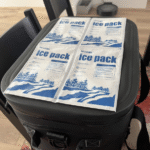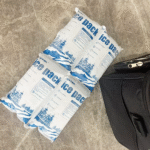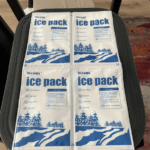How Do Dry Ice Pack Sheets Improve Meat Shipping?
Shipping meat requires precise temperature management to ensure product quality and safety. Dry ice pack sheets are a highly effective solution for maintaining ultra-low temperatures, ensuring that meat remains frozen during transit. This guide will explore how dry ice pack sheets can revolutionize your meat shipping process, focusing on safety, eficiência, e o mais recente 2025 tendências.
-
O que são folhas de embalagens de gelo seco, and how do they work for meat shipping?
-
What benefits do dry ice sheets offer over traditional cooling methods?
-
How can businesses ensure safe handling and packaging with dry ice sheets?
-
What are the latest cold chain innovations in meat shipping for 2025?
What Are Dry Ice Pack Sheets, and How Do They Work for Meat Shipping?
Dry ice pack sheets are specially designed sheets filled with dry ice pellets, which provide continuous cooling through the process of sublimation. Dry ice sublimates directly from solid to gas at an extremely low temperature of -78.5°C (-109.3°F), which makes it an ideal choice for shipping perishable goods like meat.
These sheets are an essential component of meat shipping because they maintain temperatures well below freezing for extended periods. As dry ice absorbs heat from its surroundings during sublimation, it keeps the meat at a consistent low temperature, reducing the risk of bacterial growth and preserving the freshness of the product.
Principais recursos:
-
Ultra-Low Temperature: Keeps meat frozen at temperatures as low as -20°F (-29°C) por períodos prolongados.
-
Sem derretimento da água: Ao contrário dos pacotes tradicionais de gelo ou gel, gelo seco sublima diretamente no gás, leaving no water behind, preventing soggy packaging.
-
Vida útil estendida: Ensures that meat remains fresh and safe for longer durations during transit.
How Do Dry Ice Pack Sheets Maintain Temperature During Meat Shipping?
Dry ice works efficiently to maintain the temperature inside a shipment by releasing cold carbon dioxide gas. Como se sublima, the gas absorbs heat from the surrounding air, ensuring a steady low temperature. Research shows that dry ice can maintain freezing conditions for up to 48 horas, making it perfect for long-distance shipments.
By adjusting the amount of dry ice used, businesses can customize the cooling effect for different types of meat, such as beef, aves, ou frutos do mar. Por exemplo, poultry may require less cooling than beef, and dry ice sheets allow for precise adjustments to ensure that each shipment is kept at the right temperature.
Aplicação prática
| Temperature Control Method | Tempo de tempo | Eficácia | Aplicação prática |
|---|---|---|---|
| Camas de gelo seco | 24-48 horas | Highly Effective | Ideal for long-distance meat shipping |
| Pacotes de gel | 12-24 horas | Moderado | Suitable for shorter shipments or non-frozen meat |
| Bolsas de gelo | Varia | Low to Moderate | Best for sturdier products or less temperature-sensitive items |
What Are the Benefits of Using Dry Ice Pack Sheets for Meat Shipping?
Using dry ice for meat shipping presents several key advantages compared to other cooling methods like gel packs or ice.
1. Longer Shipping Durations
Dry ice maintains a consistent ultra-low temperature for longer than other methods, allowing meat to stay frozen for up to 48 horas. This is crucial for long-distance or international shipments where timing and temperature control are critical.
2. Non-Toxic and Efficient
Gelo seco sublima -se em gás, leaving no water behind. This prevents damage to packaging and ensures that meat remains dry, unlike traditional ice, which can melt and potentially affect the quality of the meat.
3. Customizable Cooling
The quantity of dry ice used can be adjusted to meet specific shipping needs. This flexibility allows businesses to tailor the cooling method depending on the duration of the shipment and the type of meat being transported.
Additional Advantages:
-
Deterioração reduzida: Keeps meat at the optimal temperature, reducing the risk of spoilage and maintaining freshness.
-
Econômico: Fewer spoilage-related losses result in cost savings, as businesses can reduce returns and increase customer satisfaction.
Best Practices for Safe Meat Shipping with Dry Ice Sheets
To maximize the effectiveness of dry ice pack sheets, businesses must follow best practices for packaging, rotulagem, e manuseio.
Packaging and Layering
To ensure that meat remains frozen during transit, the dry ice should be layered at the bottom and top of the insulated container. Avoid direct contact between the dry ice and the meat to prevent freezer burn.
-
Use High-Quality Insulated Containers: Styrofoam boxes or thermal liners work best to minimize heat transfer.
-
Preencha espaços vazios: Use packing materials like crumpled paper, plástico bolha, or foam inserts to prevent movement and enhance thermal efficiency.
-
Ventilação: Ensure that the container is properly vented to allow the sublimated gas to escape. This prevents dangerous pressure buildup inside the package.
Regulatory Compliance for Meat Shipping with Dry Ice
When shipping meat with dry ice, businesses must comply with various regulations to ensure safety and proper handling. This includes accurate labeling, diretrizes de embalagem, and documentation.
-
Rotulagem: Mark the package with “Gelo Seco” ou “Carbon Dioxide Solid,” along with the UN1845 number and net weight of the dry ice.
-
Documentação: Include any necessary documents, such as a Bill of Lading or Material Safety Data Sheet (MSDS), based on carrier requirements.
-
Medidas de segurança: O gelo seco é classificado como um material perigoso, so appropriate safety precautions must be followed, including using insulated gloves and ensuring proper ventilation during handling.
Emerging Trends in Meat Shipping: 2025 Inovações em cadeia fria
As the demand for safe and fresh meat grows, innovations in cold chain logistics are continuously evolving. Some of the key trends for 2025 incluir:
-
Sustainable Dry Ice Production: Methods for producing dry ice from renewable carbon capture techniques are being developed, reduzindo o impacto ambiental.
-
Smart Monitoring Technology: IoT devices that track temperature and humidity in real-time are becoming standard, providing businesses with the ability to monitor shipments and adjust as necessary.
-
Materiais ecológicos: Companies are increasingly adopting sustainable materials in packaging, such as biodegradable films and recyclable insulation.
Perguntas frequentes
Q1: How long can dry ice keep meat frozen during shipping?
A1: Dry ice can keep meat frozen for 24-48 horas, depending on the amount used and shipping conditions.
Q2: Is dry ice safe to use for shipping meat?
A2: Sim, dry ice is safe when handled properly. Always wear gloves to prevent frostbite and ensure adequate ventilation during shipping.
Conclusão e próximos passos
Para concluir, dry ice pack sheets are a reliable and efficient solution for businesses shipping perishable meat products. By using these sheets, businesses can ensure that meat remains frozen and safe throughout transit, improving customer satisfaction and reducing losses.
PRÓXIMOS PASSOS:
-
Avalie suas necessidades de remessa: Assess the duration, peso, and packaging of your meat shipments.
-
Incorporate Dry Ice Pack Sheets: Use the appropriate amount of dry ice based on your shipment requirements.
-
Ensure Compliance: Follow all labeling, embalagem, and safety regulations to avoid mishaps during shipping.
Sobre Tempk
Tempk é um provedor líder de soluções de cadeia fria, specializing in dry ice pack sheets for meat shipping. Our solutions are designed to maintain optimal temperatures, garantindo a segurança e a qualidade do produto. We help businesses of all sizes navigate the complexities of cold chain logistics, offering professional advice and innovative packaging solutions.
Contact us today for expert guidance on dry ice pack sheets for meat shipping!
























